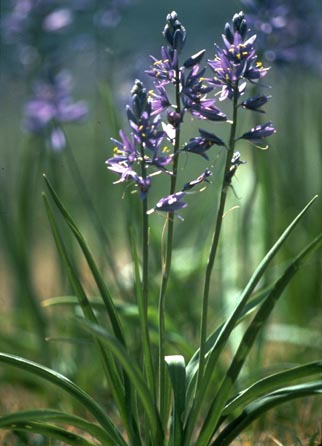Blue Camas

Common Name(s):
Blue Camas
Small Camas
Quamash
Wild Hyacinth
Scientific Name:
Camassia quamash (Pursh) Greene
Scientific Name Synonyms:
None Known
Symbol:
CAQU2
Description:
Life Span: Perennial
Origin: Native
Growth Characteristics: Blue Camas is a native Monocot. It reproduces from seed and bulb offsets. Clones flower at 2 or 3 years of age, from May to July, depending upon the elevation and snow cover. Leaves die and seeds are dispersed from late May to August.
Flowers: Terminal raceme with buds that open into six slender, loose petals. Color can range from white to deep blue.
Fruits/Seeds: A three-celled capsule with 5-10 seeds per cell.
Leaves: Basal, turf-like, reaching about 18 inches tall.
Stems: 8 to 36 inches in height.
Ecological Adaptions:
Blue Camas is commonly found in mountain grassland and prairie communities. It grows on sites that are moist to wet in spring but dry by late spring or summer. It is commonly found near vernal pools, springs, and intermittent streams. It occurs in Utah at elevations from 6240 to 7950 feet. It is shade intolerant, and in forested areas, it is found only in open sites created by disturbance.
Soils: Prefers a moist acidic soil, with good drainage.
Uses and Management:
Blue camas is grazed by livestock, elk, and moose. Pigs are known to consume the bulbs.
The bulbs were eaten by western Indians, trappers, and early settlers. Many western Indian tribes also used the bulbs as a trade item. It was eaten raw, roasted, boiled, fried, or was dried and stored.

